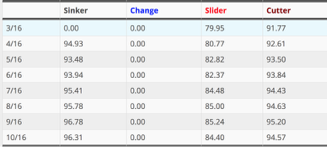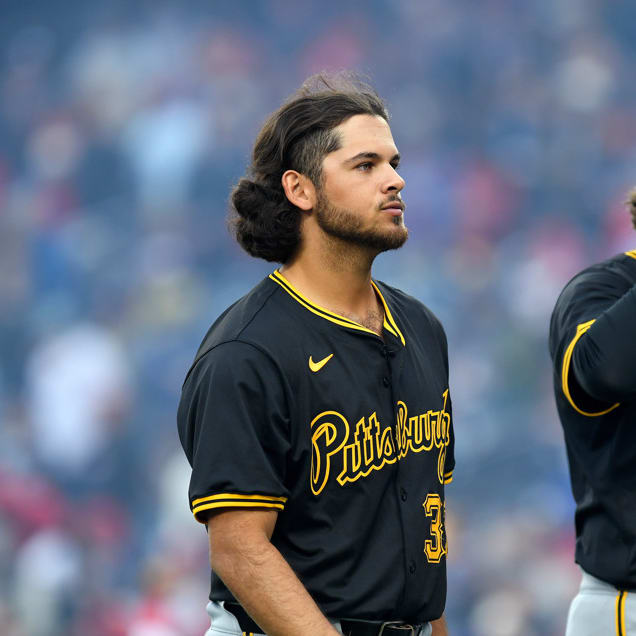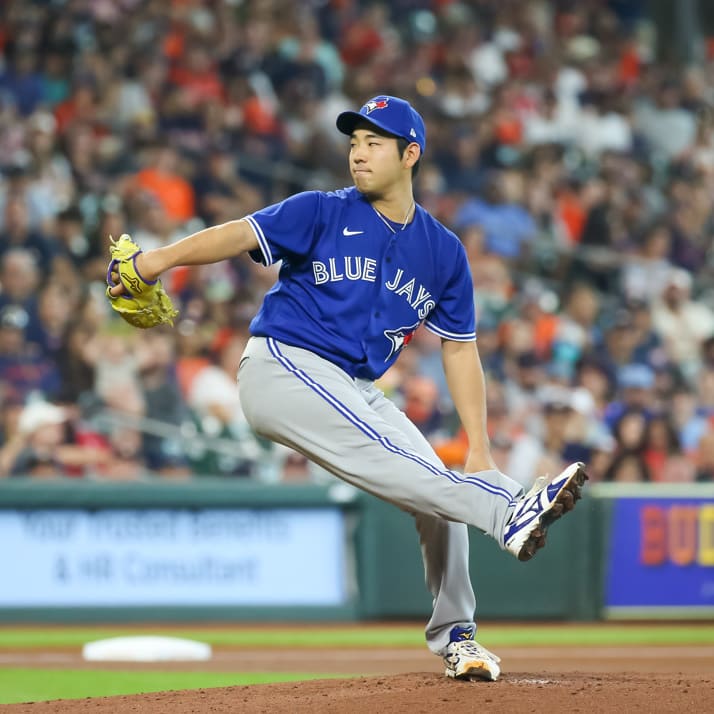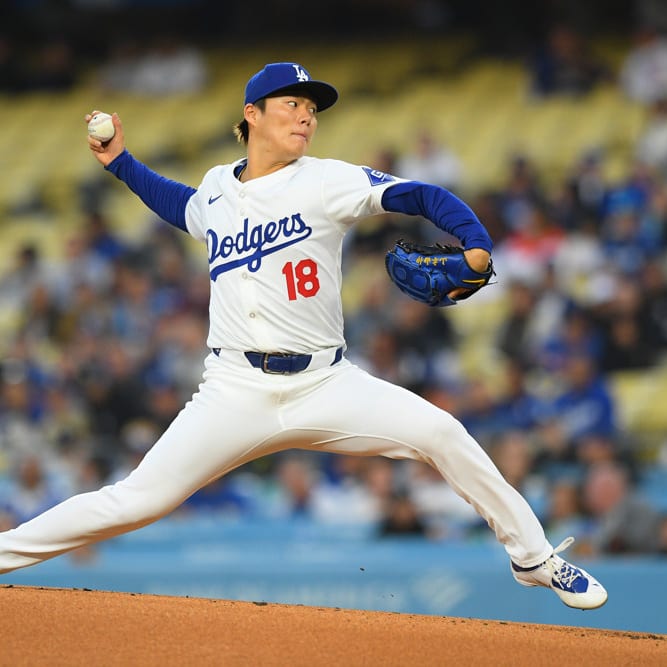This article is part of our MLB Barometer series.
Remember when Ryan Zimmerman had 11 homers and a .420/.458/.886 last April?
That was the same month that Jason Vargas looked like Clayton Kershaw.
How about Alex Bregman's .250/.340/.310 opening month last season without a home run? (At least he's got one so far in 2018!)
It's easy to get caught up in the early-season production we've banked – or missed out on – as the calendar flips to May. Understandably, our patience begins to run thin, and we want to believe that the players currently carrying our teams at or near the top of the standings are producing at new and improved sustainable clips.
This week's risers and fallers focus on a few of the biggest movers in each direction from the first month-plus of the 2018 season. Naturally, this list is not exhaustive, as Didi Gregorius has been a $50(!) player to this point, and he is likely the biggest riser in the player pool since draft day.
Starting next week, I will begin to focus on adjusted values for various position groups, in addition to featuring players trending in both directions with their roles and recent production.
RISERS
A.J. Pollock, OF, ARI - Pollock's fast start to 2018 has started to quell my concerns that his power production maxed out when he hit 20 homers in 673 plate appearances for the D-backs in 2015. The early returns have been excellent for those who were willing to draft him as a fringe top-50 player several
Remember when Ryan Zimmerman had 11 homers and a .420/.458/.886 last April?
That was the same month that Jason Vargas looked like Clayton Kershaw.
How about Alex Bregman's .250/.340/.310 opening month last season without a home run? (At least he's got one so far in 2018!)
It's easy to get caught up in the early-season production we've banked – or missed out on – as the calendar flips to May. Understandably, our patience begins to run thin, and we want to believe that the players currently carrying our teams at or near the top of the standings are producing at new and improved sustainable clips.
This week's risers and fallers focus on a few of the biggest movers in each direction from the first month-plus of the 2018 season. Naturally, this list is not exhaustive, as Didi Gregorius has been a $50(!) player to this point, and he is likely the biggest riser in the player pool since draft day.
Starting next week, I will begin to focus on adjusted values for various position groups, in addition to featuring players trending in both directions with their roles and recent production.
RISERS
A.J. Pollock, OF, ARI - Pollock's fast start to 2018 has started to quell my concerns that his power production maxed out when he hit 20 homers in 673 plate appearances for the D-backs in 2015. The early returns have been excellent for those who were willing to draft him as a fringe top-50 player several weeks ago, as he's piled up seven homers, six steals, 18 runs and 22 RBI over 27 games while providing a much needed No. 2 contributor behind Paul Goldschmidt in the Arizona lineup. The biggest difference for Pollock's batted-ball profile through the first month is the increased flyball rate (42.5 percent – up 10.1-percentage points from his career 32.4 percent mark), and while the seemingly altered approach has led to a career-high strikeout rate (23.9 K% entering play Monday), it's also led to a spike in hard contact. With a barrel rate that has jumped from 4.3 percent in 2017 to 8.3 percent to begin 2018, Pollock is showing base skills that may actually support the possibility of the 30-homer, 30-steal pace he's currently on. It also helps matters that the NL West is loaded with left-handed pitching – all five teams in the division currently rank in the top-seven in plate appearances against lefties in 2018, while Pollock has posted a 125 wRC+ against southpaws since the start of 2015. The key for Pollock will be avoiding the nagging leg injuries that have sapped his production at various points during his time with the D-backs.
Ozzie Albies, 2B, ATL - If we are ranking early 2018 surprises, the power outburst from Albies is second only to the statistical theatre that is Didi Gregorius to this point. As a 21-year-old, small-framed, switch-hitting middle infielder, it was fair to question the power expectations for Albies after he swatted six homers in 244 plate appearances last season. He's now sitting at 15 homers through 84 MLB games, backed by a career .288/.350/.523 line. I thought the helium throughout draft season on Albies was warranted, but I expected the production to fall much closer to .275/.335/.465 with 13-15 HR, 25-plus SB, and a lot of runs scored as the Braves' No. 2 hitter. Instead, Albies is looking like a player who might be gone within the first 40 picks if we were drafting from May 1 on.
Mike Moustakas, 3B, KC - A surprisingly soft free-agent market for Moustakas during the offseason left him with a one-year, $6.5 million deal to return to Kansas City. With Lorenzo Cain and Eric Hosmer getting big multi-year deals elsewhere, the supporting cast took a big hit, or so we thought. The Royals had a team wRC+ of 89 and 91 in 2016 and 2017 respectively, and they're currently sitting with an 86 mark in 2018. Moustakas has been one of the best bargains of the winter as he's sustained the power growth from his career-high 38-homer campaign in 2017. I made a call for draft-day mulligans in last week's column, and I wonder if there are any teams with regrets about not scooping up Moose Tacos for next to nothing.
Rick Porcello, SP, BOS - Through six starts, Porcello is tied with Max Scherzer with the second-highest fWAR (1.6) among all MLB starters; only Gerrit Cole is higher (1.8). After winning/stealing the 2016 AL Cy Young Award, Porcello's ratios ballooned from a 3.15 ERA and 1.01 WHIP to a 4.65 ERA and 1.40 WHIP last season. While a spike in his home-run rate was largely the culprit, the unsightly ratios left many to write him despite a heavily reduced price during draft season. Underneath the terrible ratios, Porcello posted the highest swinging-strike rate of his career last season (9.4 percent) and maintained a K/9 over 8.0 for the first time over a full season. The early success in 2018 has been founded on an increased use of his slider and changeup (at the expense of his fastball and curveball). It took me a few weeks to fully buy back in, as Porcello sat on my bench in Tout Wars to begin the season while Jake Faria was crushed twice by the Red Sox and Sonny Gray was walking the world. He'll inevitably begin giving up homers again (2.6 HR/FB%, 0.22 HR/9), and he won't continue to start against the Rays for half of his matchups, but he might be a top-40 starter again when you consider the premiums that will be placed on high-IP starters on good teams and the subsequent elevated win total potential.
Josh Hader, RP, MIL - The Brewers are using the bullpen in a way that can make fantasy baseball more challenging, but in a way that is effective and refreshing. Hader's dominance was on full display Monday night against the Reds, as he recorded the final eight outs of the night – all via the strikeout – to pick up his fourth save of the season.

When Corey Knebel suffered a hamstring injury in early April, there was a lot of uncertainty about who the Brewers would use to finish games in his place. My theory was that Hader's multi-inning role as part of the bridge to the ninth was simply too valuable to make him a guy who would be limited mostly to traditional save opportunities. For that reason, Jacob Barnes, Matt Albers, and Jeremy Jeffress all made more sense for those chasing saves. Albers and Barnes have each closed out a game in Knebel's absence, but Hader is entrusted with the heaviest workloads and the most difficult situations, and he's now sitting with a 39:5 K:BB, 1.00 ERA and 0.50 WHIP in 18 innings. How many relievers would be on your draft list ahead of him if you were starting a season tomorrow?
FALLERS
Corey Seager, SS, LAD - As I started the process of whittling down the list of players to feature this week, Seager was a questionably healthy, underperforming member of a Dodgers' offense that has nearly underperformed across the board this season. By the time I sat down to write up the final product, the Dodgers had revealed that Seager was going to have Tommy John surgery, and that his 2018 season was over. Through 26 games, Seager was carrying the lowest strikeout rate of his career (14.8 percent), but his .257/.339/.366 line was one of the worst for an early-round pick to this point. The caution light was turned on when Seager was brought along very slowly this spring, after he avoided surgery on his elbow during the offseason. Yankees shortstop Gleyber Torres had Tommy John surgery last June, and he was "full-go" for the start of spring games in February, so the hope is that Seager will be 100 percent for the start of 2019. For those who end up having to play for the future in keeper and dynasty leagues, Seager is a great long-term piece to acquire as he just turned 24, and he still has a .300-30-100 season in his future.
Buster Posey, C, SF - Posey's days as a top-100 overall player might be over, even with the current state of the catcher position (see: disaster). He's still a good real-life hitter, and still a useful fantasy player, but the difference between Posey and J.T. Realmuto in ADP this draft season was approximately 50 picks. Now that Realmuto is back from the DL, it seems nearly impossible that Posey will outearn Realmuto by a margin large enough to justify that gap. The excellent approach is still a core part of Posey's game, but he's hitting the ball on the ground at a 52.7 percent rate (entering play Monday night) – a full-season career-high if he keeps up the early trends – and the addition of Andrew McCutchen and Evan Longoria to the Giants' offense over the offseason hasn't moved the needle with his run-production thus far either.
Matt Carpenter, 1B/3B, STL - Carpenter's patient eye at the plate and long track record of a 20-homer floor despite nagging injuries suggested that he might be a cheap source of 30-homer pop if he could shake the injury bug as part of an improved St. Louis lineup in 2018. Through 25 games, he's hit .155/.305/.274, with two homers and 10 RBI along with a career-high 24.8 K%. With that, he's also carried an average exit velocity (88.57 mph) below the league average mark (89.11 mph). After receiving just one break from the starting lineup over the Cards' first 22 games, Carpenter sat twice in the span of five games (both times against a lefty) last week. The usage doesn't hint at the possibility of a lingering injury, but nearly all of the underlying metrics suggest that something is very wrong. The most dangerous thing about waiting for a player potentially injured player with a proven track record to return to form is the risk of getting stuck with an Old Maid card and missing out on significantly better production from a critical lineup spot along the way.
Kenley Jansen, RP, LAD - If Jansen can hold the opposition to nine earned runs over his next 60 innings, he'll finish with 15 earned runs allowed in 69.2 innings this season – a 1.94 ERA. He allowed 10 earned runs throughout the entire 2017 season, so it's not completely unreasonable to think that he'll reel off a stretch of typical Jansen dominance, especially since his velocity has been trending in the right direction as April has drawn to close. According to BrooksBaseball, Jansen has averaged 92.57 mph on his cutter in April (he averaged 89.83 on the pitch in a couple of March appearances) – his lowest full month average since April of 2016.

Now 30 years old, nothing is guaranteed as far as 2018 yielding a similar month-by-month pattern with Jansen's velocity, and even if we look back at his March and April as a stretch where he simply revealed himself to be human, Jansen's position atop the closer ranks is under fire.
Chris Archer, SP, TAM - Through six starts, Archer has gone more than six innings on one occasion, and he's failed to reach the sixth inning on four occasions. For the second straight season, the swinging-strike rate is rising, but the cost of his strikeouts is becoming very steep, as his home-run rate (1.65/HR) has been well north of 1.0 since the start of 2016. A recent hot streak aside, the Rays' offense looks like a unit that will struggle to score runs for prolonged stretches, and the inefficient path to high strikeout totals makes it difficult for him to get deep into his starts each time out. He's still heavily reliant on his fastball-slider combo, as he's throwing his changeup approximately 10 percent of the time the season with a near even-mix of fastballs and sliders covering the 90 percent. If he continues to leave his starts a half-inning earlier than he did a year ago, the strikeout count that made him a potential top-20 starter will erode. At this point, a fresh start via trade, perhaps to an organization that will push him to use a third pitch more often, and one that would offer a better team context, looks like the best-case scenario.










